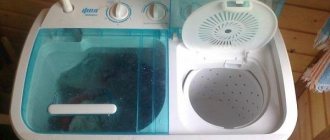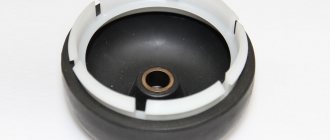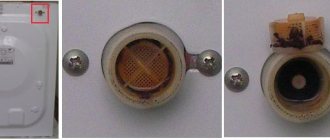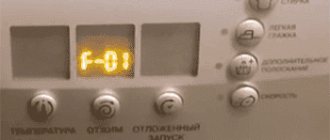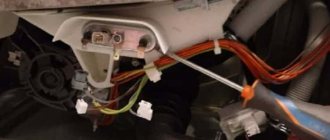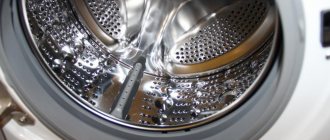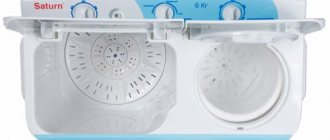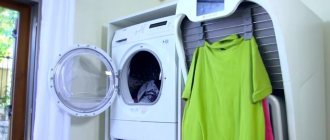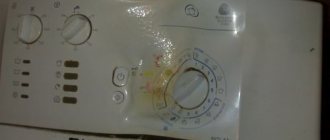Like automatic SMAs, semi-automatic machines have a number of typical breakdowns, which we will look into below - you will learn the causes of failures and ways to fix common problems.
Despite the fact that the market is overflowing with modern automatic washing machines, semi-automatic machines have not yet been forgotten. They are happily snapped up by summer residents and people living in private houses without running water.
Expert advice on using a dryer
Before putting an item into the spin cycle, you need to check the label attached to it: not all items can be subjected to centrifugal dehydration. It is also not recommended to overload the dryer. Other useful tips:
- Do not use the machine if a leak is detected until it is repaired.
- Plugging in and disconnecting the power supply must only be done with dry hands.
- Do not place the cord on a wet surface.
- Carry out preventive maintenance of the technical device: disconnect the device from the power supply and wipe it outside and inside with a damp, non-abrasive cloth, and dry it.
- To remove increased vibration: turn off the power to the centrifuge by unplugging the plug and cord from the socket, reload the drum, and, if necessary, add dry items to ensure that the entire volume is filled.
- Eliminate extraneous noise when the drum rotates: unplug the device from the outlet, tilt the cylinder to the side, and use a wire hook to remove the item caught between the machine body and the centrifuge.
If the device does not turn on, the reasons may be: the lid is not latched, a faulty start button, lack of voltage at the socket terminals, a broken wire in the electrical cord or in the wiring diagram inside the case. Such breakdowns can be repaired independently. To check the serviceability of the engine, contact a repair shop.
Centrifuges for spinning clothes are also produced for use in industrial environments - professional ones. If you have an idea to start a business in laundry services, cleaning carpets or sofa covers, car seats, you can use both a household model and a professional wringer.
How a washing machine engine works: types
Before carrying out diagnostics, you must understand what type of motor is in your washing machine and how it works. There are three main types: asynchronous, commutator and inverter centrifuge motors for automatic and semi-automatic washing machines.
Asynchronous is installed in Bosch, Siemens, Millet, Ardo and Kandy washing machines. The cheap and quiet motor has a simple design: a stator and a rotor. Large dimensions and low performance have left the asynchronous motor a thing of the past. Therefore, it was used in early models of the above machines.
The commutator motor is now actively used in the brands SMA Indesit (Indesit), Ariston, Zanussi, Electrolux, Samsung, Veko. The belt-type motor has compact dimensions and sufficient power. Transmits revolutions using a belt to the drum pulley. Its design is a little more complicated than the previous type: a stator, a rotor, two brushes and a tachometer that controls its speed.
The direct drive (inverter) modern engine has just begun to conquer the user. Installed on LG and Samsung models. The motor does not have a belt, but is directly attached to the drum, transmitting speed to it. Its structure is similar to an asynchronous motor, but the direct drive motor is compact, powerful and rarely fails.
Why doesn't the centrifuge drum spin?
The centrifuge drum most often does not spin or does so slowly for two reasons.
- The engine starting capacitor is broken, dried out, or otherwise damaged.
- The brake cable has become loose.
The capacitor can only be checked with a special device. Therefore, the easiest way is to replace this element with a new one with a rated capacity. An indicator that such repairs need to be made looks like a strained, leisurely start. The set of revolutions is slow, and the tank does not spin up to the set rotation speed.
Diagram of a semi-automatic washing machine with a centrifuge
The cable is checked by rotating the drum. To do this, close the lid or close the control limit switch. Then you need to try to turn the centrifuge drum. If it turns with force, it is necessary to restore the cable tension.
When both checks fail, you should carefully inspect the drum. If there are streaks on it, most likely moisture has entered the engine. This means that the drive needs to be replaced. And don't forget to install a new oil seal. If the drum is visually clean, you should move on to checking the contacts. Unfortunately, many manufacturers offer unreliable connection options. And the wiring tends to oxidize.
Timer problem
The timer in most semi-automatic washing machines (SMP) is located under the top panel of the unit. It can be repaired by cleaning the contacts.
There can be many tips on how to remove the panel, due to the design features of machines from different companies. After removing the top panel, you will see a device that resembles a clock with gears. Inside it you can see contacts, which can burn out during prolonged use of the unit. Soot appears on them, preventing current from passing through.
You need to disassemble the timer carefully. The mechanism cover also serves to attach gears to it. After unscrewing the three screws, it must be removed so that the gears do not fall out. If you are afraid that you may not remove the cover carefully, then it is better to photograph the mechanism. After opening the cover, you will see the contacts. As with the sensor, they must be wiped with alcohol.
[custom_ads_shortcode2]
Why doesn't the centrifuge drum spin?
The centrifuge drum most often does not spin at all or does so slowly for two reasons.
- The initial motor capacitor is broken, dried out, or otherwise damaged.
- The brake cable has become loose.
You can only check the capacitor with a special device. Therefore, the easiest way is to replace the real element with a new one with a rated capacity. An indicator that such repairs need to be brought in looks like a strained, leisurely start. The set of revolutions is such a slow thing, and the tank does not spin up to the specified rotation speed.
Switching the device of a semi-automatic washing machine with a centrifuge
The cable is checked by rotating the drum. To do this, close the lid or close the control limit switch. Then you need to learn from your own experience how to turn the centrifuge drum. If it turns with force, the cable tension needs to be regenerated.
When both checks fail, you just need to carefully inspect the drum. If there are streaks on it, most likely, moisture has entered the engine. This means that the drive needs to be modified. And don't forget to install a new oil seal. If the cylinder is visually clean, you should proceed to checking the contacts. Unfortunately, many manufacturers offer unreliable connection options. And the accompaniment tends to oxidize.
Brake pads
How does the braking system work in semi-automatic cars? Brake pads are installed under the centrifuge and provide braking when the door is opened. It is connected to the lid via a cable. When the lid is opened, the cable is tensioned and the brake pads grip the rotating part of the engine - the centrifuge is braked.
You should open the rear wall of the SMP and check the tension of the cable and that the pads are not touching the engine when the door is closed. It is the contact of the brake pads that sometimes prevents the electric motor from starting.
[custom_ads_shortcode3]
Simple solutions to emerging problems
During washing, household appliances sometimes stop performing subsequent actions or, in simple terms, may freeze. You cannot eliminate complex reasons for refusal, but there are also simple, sometimes ridiculously offensive ones. Here are the most common causes of simple washing machine failures.
The weight of the laundry exceeds the norm
Some models have a built-in smart sensor that is responsible for exceeding permissible limits. What to do in this case is very clear - remove excess laundry and start the machine again. If everything is normal, then you have correctly identified the cause.
Incorrect task
Sometimes users set a delicate wash, and then panic that the machine has stopped and won’t spin. There is no such function in this mode, and automation has nothing to do with it. Turn on forced drain and then spin mode.
An imbalance has occurred
When washing small and large items, an emergency situation may occur when the laundry collects in a single lump in one part of the drum. The imbalance sensor is triggered and a stop occurs. Not all users immediately understand the reason for the equipment failure, however, when opening the loading hatch, everything becomes clear: you need to evenly distribute the laundry items inside the drum and start the spin mode from the beginning.
Program selection error
Users sometimes make basic mistakes by choosing several washing modes at once. As a result, the washing machine stops without finishing washing. For example, the housewife chose the “Soak”, “Wash” and “Bleaching” program. Smart technology will stop in the middle of the process, because it does not have a combined “Whitening” and “Soaking” mode: they must be launched separately.
Manufacturers of modern automatic devices always very clearly describe all programs and modes, and they do not forget about the features. You should carefully study the attached instructions to avoid annoying mistakes. Household appliances wash in stages and strictly according to the programmed program, so carefully select the desired mode.
DOMOSTROYPlumbing and construction
In the centrifuge of a washing machine, during spinning, the laundry moves in a circle with a constant modulus speed in the horizontal plane. What is the direction of its acceleration vector?
1) along the radius from the center of the circle
2) along the radius to the center of the circle
3) vertically down
4) in the direction of the velocity vector
The movement of laundry in the centrifuge of a washing machine in a circle with a constant absolute speed occurs due to the presence of centripetal acceleration, which rotates the speed vector. This acceleration is directed along the radius of the circle towards its center.
The force acting on the laundry (mass element) presses it to the edges of the centrifuge, therefore it is directed from the center. The direction of acceleration coincides with the direction of force.
Newton's second law in its usual formulation cannot be applied to a rotating frame of reference, since it is not inertial. Your “down force” is the inertial force, which is in the opposite direction to acceleration.
Physics question:
In the centrifuge of a washing machine, during spinning, the laundry moves in a circle with a constant modulus speed in the horizontal plane. In this case, its acceleration vector is directed. 1) along the radius from the center2) along the radius to the center of the circle3) vertically down4) in the direction of the velocity vector
Do you know the answer? Share it!
How to write a good answer?
To add a good answer you need:
- Answer reliably those questions to which you know the correct answer;
- Write in detail so that the answer is comprehensive and does not prompt additional questions;
- Write without grammatical, spelling and punctuation errors.
You shouldn't do this:
- Copy answers from third-party resources. Unique and personal explanations are well appreciated;
- Answer not to the point: “Think for yourself,” “Easy,” “I don’t know,” and so on;
- Using swear words is disrespectful to users;
- Write in UPPER CASE.
Features of the cars
The Saturn washing machine is presented in only one variation: semi-automatic. They differ from automatic ones in two important features.
Namely:
- Water must be filled in manually, since the machine is not connected to a centralized water supply.
- The fluid temperature must be adjusted manually.
They are fairly small plastic containers into which laundry is loaded, as well as water and powder. After this, the washing machine hose is led into the sink, and the device starts.
SATURN ST-WK 7603
Low price
One of the most important advantages of such mechanisms is their low cost. Despite the fact that spare parts for the Saturn washing machine, including the gearbox, are not very cheap, the final price of the mechanism is amazing. It is perfect for infrequent use, for example, at the dacha or in a country house. By spending not too much money, you can forget about dirty clothes. The stereotype that cheap things are always very bad was destroyed in this case.
Semi-automatic washing machine SATURN ST-WK7613
Large volumes
Unlike many mechanisms of this type, this model is capable of storing a considerable amount of dirty clothes. The instructions for the Saturn washing machine say that about 5 kilograms of clothes can be loaded into it at the same time. At the same time, her “colleagues” cannot accommodate more than 2-3. Thanks to this, you won’t have to buy cars for the whole family, break them down and pay for expensive repairs at the same time.
Low noise level
The Saturn washing machine is quite quiet and inconspicuous. Her work does not distract from the affairs of the rest of the family. Many users note that the machine does not even make noise, which is uncharacteristic even for automatic mechanisms, let alone a semi-automatic machine. There are no unnecessary sounds even when overloaded or unbalanced. But this advantage is not typical for the entire line: some models, on the contrary, are too loud. This is offset by an even lower price.
Saturn ST-WM 1615
Independence from water
The main advantage that the Saturn washing machine and any semi-automatic machine in principle has is its independence from a centralized water supply. Its circuit and gearbox are organized in such a way that all the liquid poured during startup is enough for exactly one wash. This solution is perfect for country houses where the water supply operates only a few hours a day.
Excellent spin
Despite the fact that the Saturn washing machine gearbox is not particularly powerful, its repair is required quite often, and the durability of the spare parts still leaves much to be desired, one cannot blame the machine for poor quality. She copes with her tasks perfectly, washes any stains and thoroughly wrings things out. Thanks to this, you practically do not have to do anything yourself.
SATURN ST-WK 7605
Huge water consumption
Quite a few semi-automatic machines try to use water sparingly so as not to ruin their owners. Unfortunately, the same cannot be said about this mechanism. Reviews indicate that the machine's layout is not optimized. Because of this, it requires too much water, while not using half of what is requested. However, the instructions say that this consumption can be reduced with your own hands.
Short hose for filling water
Most spare parts leave much to be desired, and the water drain hose is no exception. It's too short and not strong enough. Therefore, when the centrifuge spins at full speed, the hose simply jumps out of the sink, flooding your machine and leading to the need for repairs. Even though the machine operates with water, contact with liquid may cause a short circuit.
Fragile spare parts
Saturn washing machine repair is a service that machine owners cannot do without. And, if some spare parts are made to perfection, such as a centrifuge, then others cannot withstand even small loads. The body is considered the most fragile, so you should not put weights on the plastic or try to lean on it. Nothing good will come of such an undertaking.
Love for "eating" electricity
As mentioned above, the semi-automatic circuit is not very optimized, as a result of which the mechanism, including the gearbox, is resource-intensive. This proposal also applies to electricity. In one cycle, some models in the line are capable of “eating” more than a full-fledged electric boiler or powerful PC would. Therefore, the car is not suitable for those who like to save money.
Description of common breakdowns and their causes
A semi-automatic washing machine has a fairly impressive list of breakdowns that are associated with its specific design. Let's look at them.
When the spin is activated, the engine does not start - it does not work. A serious problem that can be caused by burnt contacts or broken power wires going to the electric motor. In this case, immediate repair is required.
The mechanical timer, temperature sensor, or the motor itself may also be faulty. The capacitor or relay responsible for starting the engine does not work. The transformer has burned out or the motor brushes have worn out - you need to disassemble and repair the motor.
The engine has started, but the centrifuge drum does not rotate. This problem occurs when there is too much wet stuff in the tank. The second option is that the brake is not working properly, blocking the rotation of the drum. Also, the centrifuge drum will not rotate if there is too much water in the tank, and even more so if large foreign objects, such as laundry, have gotten into it. Repairs are often not required here.
When the engine of the semi-automatic Slavda (or other) machine is running, the drum is blocked and does not rotate. There are usually two reasons for this malfunction:
- Firstly, the laundry in the drum is laid on one side. This leads to the fact that, under the influence of centrifugal force, the rotor swings and strongly hits the edges of the tank - spinning is impossible and the machine does not work.
- secondly, if a semi-automatic machine with a centrifuge has already been in use for some time, its bushings may be broken. With broken bushings, normal rotation of the rotor is also impossible. If the bushings are broken, repairs are needed.
During the spin cycle, water flows from a semi-automatic machine with a centrifuge. In this case, there are quite a few possible causes of the malfunction, let's list them.
- The tank is leaking and is leaking water.
- The connecting elements and the connections between the hoses and the centrifuge units are broken or loosened. Most often, the connection between the hose and the pump or tank.
- The diaphragm or its fastenings are broken.
- The drain valve cuffs are worn out and do not hold water.
- The drain pump has damage to its housing.
- The drain valve is faulty - the opening/closing mechanism does not work.
- One of the pipes or hose has leaked.
- The rubber seals on the drain pump cover are worn out and do not hold water.
The drain pump does not drain or does not drain waste water well from the centrifuge tank; in general, it does not work normally. The reason for this may be a serious blockage in the drain pump or hose of the semi-automatic Slavda (or other) washing machine. Or the impeller blades have broken, causing the pump to turn on and run, but the water will drain extremely slowly. Poor drainage can also occur if laundry gets into the drain hole of the centrifuge, or the drain hose is accidentally pinched.
Water flows from tank to tank. If water from the washing machine tank tries to leak into the centrifuge tank, this can only mean one thing - a problem with the bypass hole. More precisely, the problem is in the valve; if its rubber gasket has worn out and no longer holds water, that’s where the problem comes from. Repair needed.
What if a semi-automatic machine with a centrifuge does not turn on at all? The cause may be a faulty power supply wire, plug, or relay. In addition, a similar “symptom” can occur when the electric motor burns out.
Electrical repair required. If the engine is running but the drum refuses to rotate. In this case, there is only one problem - the drive belt.
It can come off or tear, and the drive is naturally not provided. Repair needed.
Note! In addition to the above malfunctions, other problems can often arise with semi-automatic machines that cannot be called a malfunction in the literal sense of the word. For example, problems with the water level sensor can be solved by straightening the drain hose.
[custom_ads_shortcode2]
What to do if the washing machine does not spin
Before you do anything or start repairs, you need to make sure that the problem is broken. Perhaps you simply turned off the spin, so the machine does not finish the program.
Look at the control panel; perhaps the no-spin mode is accidentally turned on, or the delicate wash program is set, in which there is no spin. Then you need to set the normal washing mode and adjust the number of revolutions.
Top-loading washing machines may react to an overload of laundry. Also, with a small number of things, an imbalance could occur, when all the laundry gets bunched up into one lump, and the work of the SMA stops. In this case, the washer may try to spin the drum several times, after which it stops. You need to open the door and remove excess clothing or distribute it throughout the drum.
If you have checked all the options, but the SMA still does not turn on the spin mode, then proceed to diagnose the parts.
When draining
If the Bosch, Ardo, Ariston or Zanussi SMAs stop and do not drain water, the reason must be sought in the drain pump. There may also be a situation when the machine drains the water, but does not spin it out. There may still be some water left in the drum, which is why the spin cycle does not work.
- There is a drain hatch at the bottom of the front hull.
- Release the hatch latches and open the door.
- Place the container and remove the filter.
- To check the pump impeller, run the spin or drain mode.
- Shine a flashlight into the hatch hole and check if the impeller is spinning.
- If it does not spin, you need to disassemble the pump.
The drain pipe is checked at the same time as the pump. Depending on the model of the washing machine (“Atlant”, “Whirlpool”, “Veko”, “Gorenye”) you can access the pump through the bottom, front or back of the case. We wrote more about this in previous articles.
- Unclench the clamp of the pipe from the tank to the pump, disconnect it and check for blockages.
- Then disconnect the pump wiring and its mountings.
- Inspect the structure for debris; there may be something wrapped around the impeller.
If the pipe is clogged, the machine may hum, but not press, trying to drain the water. After installing the parts in place, check the operation of the machine. If the spin does not start again, replace the pump completely.
When washing
When the machine washes but does not spin, the problem may be in the washer motor. In this case, spinning is simply impossible, or it passes, but too weakly.
- Remove the rear housing and pull out the motor for inspection.
- Take out the electric brushes, which are located on both sides of the case.
- If they are worn out, replace them with new ones.
If the drum is not working well
If the SMA drum does not spin up or gain the proper speed, the reason is the Hall sensor. The device monitors the engine, but if it breaks, the engine may run erratically. The drum can spin, but not spin out the laundry, because it does not develop the required speed.
To check the tachometer, you need to remove the engine as described above. The device is located on the motor housing. If the sensor breaks, it cannot be repaired; it must be replaced with a new part.
Water flows between tanks
This is already a specific feature of semi-automatic machines: if water flows from one tank to another, the problem is most likely a worn-out overflow valve gasket. Valve repair required.
In the age of automatic washing machines, everyone has somehow forgotten about the “good old” semi-automatic equipment and how it works. We remember such machines, as a rule, only at the dacha, solving our everyday problems with the help of these “toilers”. You begin to truly appreciate a washing machine when it breaks down. What to do in such a situation, call a specialist, or carry out the repairs yourself? Everything will depend on the nature of the malfunction and much more.
[custom_ads_shortcode1]
Semi-automatic washing machine, DIY repair
Why doesn't the centrifuge spin on a semi-automatic washing machine?
The most interesting thing is that this question is mostly asked to me by women. I would like to ask, where are the men, watching football on the sofa or thinking that it is easier to buy a new one than to repair an old one, forgetting that buying an SM will take a lot of money. This is such a small digression, but now in essence
On my semi-automatic washing machine, the centrifuge motor does not spin, or rather the following happens: I start the spin cycle and the motor tries to spin up, but it’s very difficult, as if it doesn’t have enough power; if you push it with your hand, it spins up to full speed. Tell me, what could it be?
If there is no spin on the SM semi-automatic, then first of all you need to look at the capacitor, which is located near the centrifuge motor. In photo 1, you can see what it looks like. The capacitor capacity is 5 µF, you can only check it with a special device; if you don’t have one, then take a known working capacitor and connect it instead of the suspicious one. If the centrifuge starts spinning, then the cause has been found. It also happens that the brake cable weakens, in this case, close the lid on the tank and spin the drum, if the drum spins without problems, then this reason can be removed
Photo 1. Capacitor for SM semi-automatic
I replaced the container on the spin motor, but the motor still doesn’t spin, you can only hear it humming
If replacing the kander does not help, then change the engine
Pay attention to the walls of the tank inside the washing machine; if you see a picture like in photo 2, then the seal must also be changed. Photo 2
Splashes of water on the walls of the tank
Photo 2. Water splashes on the walls of the tank
The spin drum does not react at all when turned on, you can only hear the clicking of the clock mechanism
You need to test all contacts with a multimeter. In washing machines such as Saturn, Volna, etc., all the wires are connected at the nozzles, and breaks very often occur. It is also advisable to remove the timer and ring it
Why there is no spin on the Saturn washing machine, watch video
The washing motor does not spin on a semi-automatic machine
The fact is that the motor of the washing unit is located away from the tank and therefore it does not burn out as often as the motor during the spin cycle. There are several reasons for this disease, which I will explain below.
If you push the activator or the washing motor, it starts to spin, but without a push it seems to be trying to spin, but it doesn’t work. After watching the video, I still don’t understand how many capacitors are on this semi-automatic SM and what are the parameters for the washing motor
In photo 1, you will see a cander (container or electrolyte, as you wish), it is quite possible that this is the reason. The fact is that a semi-automatic machine with a centrifuge has one capacitor, but it contains two capacitors: 5 μF and 10 μF, that is, in one bag there are two bottles, one with kefir, the other with milk. 10 µF is supplied to the washing engine
The washing unit motor does not turn. If you remove the belt, the activator and motor rotate normally, but as soon as I put it in place, the motor barely turns the activator
There may be several reasons. First of all, check the capacity of the cander. Then, the belt of a semi-automatic washing machine should not be too tight. And lastly, the washing reducer is covered
Watch the video why the washing motor on a semi-automatic machine does not spin
SM semi-automatic does not drain water well
I already wrote about this problem above. The fact is that the manufacturer not only did nothing to protect the drain pump from various objects getting under its impeller, but also hid the pump in the middle of the machine body, so much so that you can’t get it out of there. Another mess is related to the pipes, they are tightly glued to the body of the washing machine and the pump, in the end, you have to work hard to clean them. Below I have posted a video about how to clean the drain channels and water drain valve, I assure you in this video there is something to laugh at and something to learn
Watch a video on how to clean a semi-automatic washing machine
In this article, I tried to consider the main breakdowns of such washing machines.
It is important to understand here that almost all semi-automatic machines are repaired in the same way, the only parts may differ slightly, in short, do not look at the name of the SM, pay more attention to the repair principle
Leaks during spin cycle
Symptoms: puddles of water under the washing machine. Possible causes of leakage:
- the tank is broken somewhere;
- the hose mounting points are loose: tighten or replace the fasteners;
- the diaphragm is broken or its fastening is damaged;
- damage to the drain valve cuff;
- cracks in the drain pump housing;
- the water drain valve is faulty;
- damage to hoses or pipes;
- The drain pump is leaking due to a damaged seal.
[custom_ads_shortcode2]
Debugg
If, when you turn the switch to the drying/spin mode, the machine does not start working or does so unnaturally (with a hum or strong vibrations), and the laundry remains wet, you should look for the reason in the incorrect operation of the centrifuge. This could be due to a number of factors:
- protective sensor failures;
- timer failure;
- jamming of brake pads;
- violation of the integrity of the electrical winding.
Important! The above cases require immediate elimination of the problem by partially disassembling the device
Safety sensor
Most modern semi-automatic machines are equipped with a special switch that stops the engine while the centrifuge is running, when the lid covering it opens. This is done for security reasons. When this sensor gets stuck in the open position of the door, the spin simply does not start. Failures may occur due to contamination of the contacts. To fix the problem, just clean them with cotton wool soaked in alcohol. You can get to the sensor by removing the top panel of the washing machine.
Timer
Just as with the safety switch, the timer is often located under the top cover of the device. It looks like a clock mechanism with gears, hidden under a transparent plastic cover. It is secured with three screws that need to be removed. Under it, among the gears, there are also contacts. Due to prolonged use, carbon deposits may form on them due to intense engine operation. Because of this, no current pulses are received and the centrifuge drum does not spin. The method for solving the problem is similar to the previous one - cotton wool and alcohol.
Brake pads
If you open the lid while the washing machine is operating, the protection system will work and the drum will gradually stop. This is ensured by the presence of brake pads located under the centrifuge. The operating mechanism is based on the tension of the cable connecting the pads to the cover. When it is in the open position, the cable is tensioned and the brake pads clamp the rotating element of the engine. This is how braking occurs.
The cable may get stuck or caught on another part, thereby actuating the braking system and preventing the engine from starting and, therefore, starting the centrifuge. To change the position of the pads, you need to open the back cover of the washing machine and check the tension of the cable when the cover is closed.
Motor winding
In cases where the centrifuge drum in the SMP does not gain speed, the reason should be sought in the motor, or more precisely, in its winding. To do this, use a multimeter to measure the resistance on the motor. Depending on what the indicators on the device are, the nature of the malfunction will become clear: a break (as well as burnout) of the wiring or a short circuit. Based on the data obtained, a method for eliminating the problem is determined.
To diagnose the condition of the winding, it is necessary to “ring” the wiring for resistance. Typically, three wires come out of the electric motor: common, for the starting and for the working winding. But to obtain more accurate information about the structure of the unit, it is recommended that you familiarize yourself with the electrical diagram, which is usually located inside the washing machine body (on one of its walls). The tester probes are applied to two different wires. If the readings on the device fluctuate between 20 and 200 Ohms, then everything is normal. When the value is less, this indicates a short circuit, and when it is more, it indicates a wire break. In the latter case, you can send the component for rewinding or purchase a new one.
Other reasons
In addition to the listed breakdowns, there are others that can disrupt the operation of the spin cycle. Often you can fix them yourself without resorting to disassembly. Among the most common causes of centrifuge malfunction are the following:
- The belt that connects the centrifuge to the engine pulleys has broken or fallen off. A breakdown can be recognized if the machine hums, but does not spin the drum.
- The laundry is unevenly distributed, causing the centrifuge to wobble but cannot start.
- Small objects getting on the motor shaft. This can happen during the spin cycle. To make everything work again, it is enough to remove foreign objects from the surface of the part.
If the spin system motor works, but things remain wet, then the reason may lie in a malfunction of the drain system. For example, an incorrectly installed hose can cause the machine to simply not drain the water squeezed out of things.
Other causes of centrifuge malfunctions in semi-automatic machines
It is very difficult to list all the reasons for breakdowns of the spin system. Different car models have their own nuances. However, if you can repair it yourself, you will save a lot of money.
Let's look at the most common causes of malfunction of the spin system .
- The motor hums loudly, but the spin does not start. This means that the belt that connects the centrifuge and motor pulleys has broken or slipped off.
- During long-term operation of the machine, the rubber diaphragm bushing may wear out . A large gap between the parts will prevent the spin cycle from starting. To make the machine work, the bushing needs to be replaced.
- If you checked the electric motor and made sure that it is working, then the reason may be a faulty thermal relay , or a step-down transformer. These parts cannot be repaired and must be replaced with new ones.
- It would also be a good idea to check whether small things are wrapped around the electric motor shaft . They may fly out during the spin cycle and end up in the middle of the machine.
- Laundry placed unevenly inside the centrifuge can cause it to wobble and prevent it from starting.
- If the activator spin motors do not work, it would be a good idea to check the fuse , which is located in the middle of the machine behind the rear panel. You can also check the electrical plug (contacts).
A semi-automatic washing machine cannot be called a simple mechanism. Therefore, some types of malfunctions can only be corrected
master
.
However, if you carefully follow our advice, carry out the necessary actions carefully and without haste, then you will be able to repair your washing machine yourself, without outside help. This is especially true for repairing a centrifuge in a semi-automatic washing machine.
TOP stores of washing machines and household appliances:
- mvideo.ru / - household appliances store, large catalog of washing machines
- holodilnik.ru – Inexpensive store of household appliances.
- techport.ru – profitable modern online store of household appliances
- citilink.ru is a modern online store of household appliances and electronics, cheaper than offline stores!
- ru.aliexpress.com – spare parts for washing machines
( 2 ratings, average 4.5 out of 5 )
Characteristics of the Volna washing machine
Volna is a semi-automatic electric washing machine. Its dimensions are 82x70x45 cm, weight - 52 kg. It consists of two parts: a washing tank and a centrifuge for spinning clothes. A detailed diagram of the wave washing machine is shown in the photo.
The washing tank is cylindrical and has a capacity of 35 liters. At the bottom of the tank there are two plastic disks that rotate in one direction. Rotation speed - 600 rpm. To allow water to flow to the sediment, there are grooves at the bottom of the tank. A special mesh protects the pump from dirt.
The centrifuge basket has the shape of a truncated cone. Its rotation speed is 1400 rpm. A maximum of 2 kg of laundry can be placed in it. The process of spinning clothes takes a few minutes.
The motor of the Volna washing machine is an asynchronous and single-phase AOLG-22-4S. Its power is 250 W. The electric motor is mounted vertically on the trolley, as shown in the diagram. The pulley of the lower half shaft is responsible for the rotation of the centrifuge, and the upper half is responsible for the rotation of the washing tank.
The Volna 59 washing machine has 2 pumps. One of them is responsible for pumping water from the centrifuge and washing tank; it works constantly. The second pump is designed to pump out the solution from the washing tank. During the washing and spinning process, this pump does not work. To activate it after completing the wash, move the handle located at the bottom of the front panel. You can repair the Volna washing machine yourself using the diagram shown in the photo.
Both tanks of the Volna 59 washing machine are equipped with lids. The developers have provided another top cover, rectangular in shape and with a flat surface. It allows you to use the top of the washing machine as a table. The spin tank lid is hinged to the rest of the body. For safety, when the lid is lifted more than 15 degrees, the engine automatically turns off and after about 10 seconds the centrifuge completely stops moving.
Washing machine activator
In accordance with the instructions included with the household appliance, to start it you only need to connect the power cord to the outlet and turn the timer lever, which is located in the center of the front panel of the case. After the time specified on the timer has expired, the washing machine turns off automatically. At the same time, Volna can process up to 4 kg of laundry: 2 kg in the washing tank and centrifuge. Do-it-yourself repair of the Volna washing machine can be seen in the video.
What is needed for repair
The list of tools that will be useful to you when repairing the SM depends on the model and the breakdown, but for almost any failure you need the following:
- pliers;
- set of screwdrivers “plus” and “minus”;
- silicone sealant or “cold welding” (CS);
- tester;
- heads, open-end wrenches (6-24 mm);
- round nose pliers.
Parts you will need:
- capacitor;
- suitable relay;
- brushes;
- drive belt;
- transformer;
- tanks - for washing and spinning;
- clamps of suitable diameter;
- elements of the drain and fill system - hoses and pipes;
- diaphragms;
- “small things”: cuff, bushing, valve, etc.
Important! You should only buy the part that is needed in a particular case. First identify the breakdown, and then go for spare parts.
Recommendations from experts
Most consumers believe that the Fairy washing machine is an obsolete model. But such a unit will for a long time be considered an indispensable assistant for women, students and those who do not have their own home.
In order for your assistant to serve for a long time, you should follow certain rules that do not create difficulties:
- Before washing, laundry must be sorted by type of material, shade and degree of soiling;
- Do not overload the washing machine;
- Do not use aggressive bleaching agents when washing;
- after each washing process, the machine should be rinsed and wiped thoroughly;
- You should not plug the washing machine into a faulty outlet; do not use a faulty electrical network.
Contacting "Aqua-master"
Aqua-master service specialists are ready to provide assistance in detecting breakdowns of varying complexity. Cooperation occurs as follows:
- The client contacts the company manager, tells him the model of the washing machine (for example, fairy-2m) and presumably the nature of the breakdown, due to which the technician must come.
- The manager appoints a specialist who is familiar with the features and characteristics of the specified model.
- At the time specified by the customer, the technician arrives on site, conducts diagnostics, and then issues a guarantee for the work done.
- The service staff uses only branded spare parts, so after repairs, the washing machine will serve its owners for a long time. We work in Moscow and settlements located in the Moscow region. To fill out an application, you can use the official website of the service center or contact its representative at the contact number.
[custom_ads_shortcode1]
VolTek Rainbow SM-5
Automatically drains water
+ Pros of VolTek Rainbow SM-5
- dimensions: 49x73x42 cm (WxHxD);
- very simple control: 2 operating modes and drain;
- there is a lint trap that effectively removes lint, hair, and fur so that they do not stick to clothes;
- you can fill in well-heated water (up to 65°C);
- reverse movement of the blades is provided;
- power consumption 335 W;
- equipped with rubberized legs;
- The corners of the machine are rounded, there is no risk of injury;
- 1.5 m inlet hose, 1.2 m drain hose;
- adequate weight – 10 kg;
- price – from 3.5 thousand rubles.
– Cons of VolTek Rainbow SM-5
- the maximum duration of the timer is 15 minutes, you need to start it several times (each time giving a five-minute rest to the engine);
- there is no protection against leaks;
- the handles of the turning mechanisms are flimsy;
- The declared loading size is not always possible: it can hold 2.5 kg of synthetics, 1 kg of wool.
